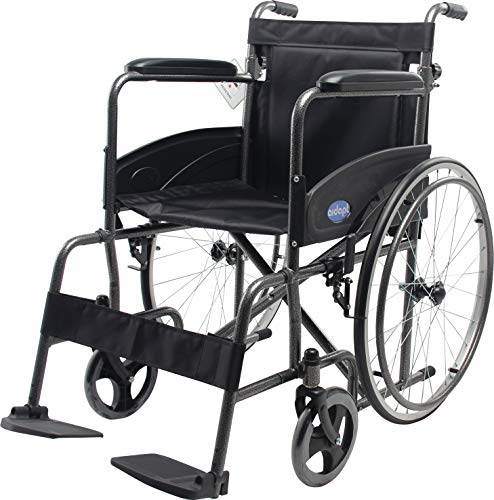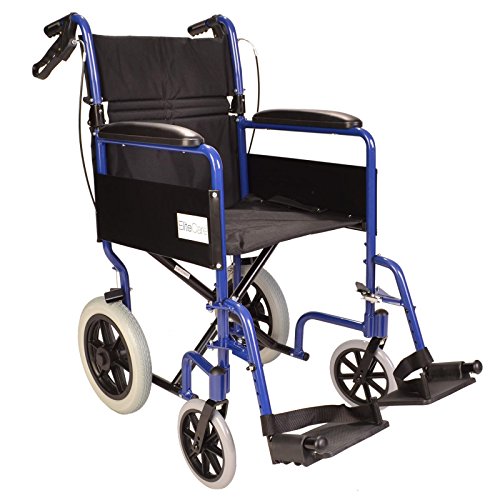See What Wheelchair With Folding Arms Tricks The Celebs Are Using
페이지 정보
작성자 Marcy Auld 작성일 24-10-14 22:37 조회 10 댓글 0본문
 Wheelchair With Folding Arms
Wheelchair With Folding ArmsA wheelchair that folds provides greater flexibility and comfort. This feature allows the chair to be folded horizontally, reducing its size and making it easy to carry and stow in cars.
A lot of these wheelchairs include elevating footrests that swing away and cushioned nylon upholstery. They also come with 8" 1" solid front casters that provide smooth and durable gliding on all surfaces.
Vertical Folding
Wheelchairs are designed with many features to provide safety and comfort. For instance, they typically feature an adjustable lumbar support. This lets the user alter the height of the support so that it is closer to their spine, which can help alleviate discomfort from pressure on various parts of their body, including the coccyx, spine, and the bottom.
Another feature common to wheelchairs is the capability to change between manual and power mode. This can be done by flipping a lever near the back wheels. This puts the wheelchair in manual mode. It will not be powered by motors, and it will be more easily maneuverable. To start the chair, just flip the lever down away from the wheelchair.
Non-folding chairs are generally constructed with strong frames that provide stability and durability. These chairs are utilized for a long period of duration and must be robust. These chairs are a good option for those who require wheelchairs that can support lots of weight.
The drawback of models that aren't foldable is that they occupy more room in the car than folding reclining wheelchair models. This is a concern if you don't have a a trunk that can accommodate a wheelchair. The weight of the wheelchair that isn't foldable can also be a problem for caregivers.
Folding wheelchairs on the other hand, could be a great option for individuals who have to move their chairs frequently. They are constructed with the ability to collapse their cross frame making them easy to transport in cars. These wheelchairs are also lighter than their non-lightweight folding self propelled wheelchair counterparts. This makes them easier to move and lift.
The present invention is a vertically folding wheelchair with a resilient stop assembly. The stop assembly comprises a pair side frame assemblies that are rotatably attached to the upper frame member. Each side frame assembly has a first steady position on one side of the linkage assembly centerline. The linkage assembly is biased toward the first stable position and is sufficiently resilient to retain the side frame assemblies in the deployed condition until the occupant selectively-manipulates the linkage assembly.
Horizontal folding transit wheelchair
This type of wheelchair folds horizontally to make it easier to put in a car. This is the most popular chair of those who have to be mobile and able to fit into vehicles with low roofs. It's also a good choice for those who only have little space in their home or car.
This wheelchair is lightweight folding travel wheelchair and easy to fold up travel wheelchair, lift and transport. The wheelchair comes in a variety of configurations. It is available with legs with adjustable heights and armrests that can swing away. The upholstery is covered in nylon to prevent mildew or the growth of bacteria. Side panels guard the legs against sliding into the wheels.
Advanced wheelchair users may be able to remove their rear wheels when they sit in the chair. This can allow them to maneuver through narrow spaces. They can also swap the tires to ones that are more suitable for their new environment or if they plan to engage in more outdoor activities.
The various types of wheelchair folding can be classified based on the direction of the hinge and the axial surface, and also their degree of tightness. (Gentle folds open folds closed folds; isoclinal folds; recumbentfolds that are overturned). Each of these categories has specific functions, like the ability to provide traction or prevent scratching.
Some wheelchairs have the ability to tilt, which is beneficial for those with low sitting capacity who are at risk of developing skin ulcers. This type of wheelchair, also referred to as a "tilt in space" wheelchair, is designed to distribute the user's weight evenly on the seat. This type of wheelchair is commonly utilized by people suffering from cerebral spinal cord injuries, cerebral, or muscular diseases that prevent them from using their legs. It's also a great option for people who want to reduce pressure and prevent pressure ulcers. It can also aid those with dizziness or scoliosis to feel more secure. A switch is usually placed on the bottom of the chair. It allows you to tilt it.
Quick-Release Wheels
The quick-release wheel system reduces the weight and size of a wheelchair once it is taken apart, and also permits easy inspection of the wheels or mounting of new tires. It is made up of a tiny rod, called a skewer, that passes through the axle, and an elongated cam lever that is positioned over the wheel to secure it in place. These systems are operated by pressing the lever with your hand. There are two main types of quick-release axles: the standard one and a bigger diameter one that is threaded into the frame. It is referred to as a through-axle.
Make sure to adjust the skewer and cam before using the quick release. The narrow end of the springs must rest against the axle ends, and when you tighten the skewer it must fit in the recess on the inner face of the cam or the adjusting nut. Otherwise, it will be bent. You can check this by spinning the spring with the adjusting nuts loose and looking for a wedge-shaped gap between the wide end of the skewer and the inner faces of the axle locknuts.
It is possible to open the lever, then close it using some force. The lever should be so tight that it leaves a mark on your palm and is strong enough to hold the wheel securely.
Some quick-releases that are cheap have plastic parts inside the mechanism, which decreases the force that you exert to clamp the wheel in place. The skewers you purchase at a bargain price may be made of a inferior quality steel, which could cause them to rust.
The lever should be placed in a way that it is flush with the frame, and has a curved shape that prevents it from snagging onto any object. Even though it appears as though the lever is securing the wheels, a protruding one signifies that it's not completely closed. If it is struck by something, a protruding wheel lever can become loose. You can prevent this from happening by making sure the lever is locked and tight before every ride.
Removable Arms
There are many types of wheelchair arm designs available that can be removed or flipped completely. Some wheelchairs are adjustable in height to accommodate lap trays. Others may support one-sided arm rests for an office posture. Armrest pads can be cushioned or upholstered, or made of hard plastic or self-skinned composite material. They are available in a variety of colors, including the classic silver vein.
If you prefer not to use armrests, there are wheelchairs that do not have arm rests whatsoever and allow the user to put their arms on the side of the chair. This can increase the functionality and make it easier to sit at a table or desk, and those who are active wheelchair users may find that armrests get in the way of their independence or cause discomfort because they are too low.
If you don't have an armrest your arms will pull your body backwards and cause you to lean forward, and then adopt a slouched position. The armrests take the weight off your arms and shoulders and let you hold things or support a tray with both hands.
Some wheelchairs include an armrest that is fixed in height and can't be removed or flipped up. This type of armrest is usually only used to transfer or to support a tray, and could hinder transfers or cause discomfort due to being at an insufficient height to offer adequate arm support.
Other models of wheelchairs have adjustable rigging that can be detached when it is not needed, and this could reduce the weight of the model to make it more convenient to move or transport. Certain models of wheelchairs feature a lighter frame as well as breathable seating materials and Mag spokes.
Wheelchairs with removable rigging are lighter than their non collapsible counterparts. They provide the same top quality, durability and safety that other mobility devices offer however, they have the added benefit of a smaller frame that makes it easier to maneuver in tight spaces and also for transportation.

- 이전글 15 Of The Best Documentaries On Automatic Folding Mobility Scooters
- 다음글 Online Poker Canada No Longer a Mystery
댓글목록 0
등록된 댓글이 없습니다.
